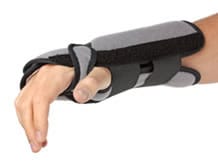
Orthotics are aimed at immobilising, supporting or partially correcting the movement of a joint, depending on the model used.
Thus, they can fight against instability and put the joint to rest to reduce the excessive stress which causes osteoarthritis.
Different types of orthotics are available nowadays:
- Simple orthotics are used in the treatment of osteoarthritis of the knee and fingers. They do not allow straightening the joint, but provide stabilisation of the joint and can provide relief. Thus, they can be useful for people who are inoperable and who suffer from severe osteoarthritis.
- Example of a simple orthosis: a reinforced or elastic knee brace. Dynamic orthotics or splints are based on orthotics used in sport. Mainly used in cases of osteoarthritis of the knee, they aim to correct the joint. However, although in some cases a reduction of varus effect has been found, these results need to be confirmed.
- Rest or immobilisation splints used for the wrist and especially the hand (osteoarthritis of the fingers and rhizarthrosis) enable placing the joint in a position that relieves stress and guards against deformity. They seem to bring real benefits as 40% of patients using a hand orthosis wears it for another 5 years after the prescription.













